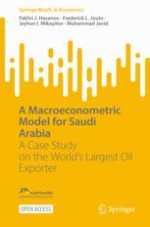This Open Access Brief presents the KAPSARC Global Energy Macroeconometric Model (KGEMM). KGEMM is a policy analysis tool for examining the impacts of domestic policy measures and global economic and energy shocks on the Kingdom of Saudi Arabia. The model has eight blocks (real sector, fiscal, monetary, external sector, price, labor and wages, energy, population, and age cohorts) that interact with each other to represent the Kingdom’s macroeconomy and energy linkages. It captures New Keynesian demand-side features anchored to medium-run equilibrium and long-run aggregate supply. It applies a cointegration and equilibrium correction modeling (ECM) methodology to time series data to estimate the model’s behavioral equations in the framework of Autometrics, a general-to-specific econometric modeling strategy. Hence, the model combines ‘theory-driven’ approach with ‘data-driven’ approach.
The Brief begins with an introduction to the theoretical framework of the model and the KGEMM methodology and then walks the reader through the structure of the model and its behavioral equations. The book closes with simulations showing the application of the model. Providing a detailed introduction to a cutting-edge, robust predictive model, this Brief will be of great use to researchers and policymakers interested in macroeconomics, energy economics, econometrics, and more specifically, the economy of Saudi Arabia.
